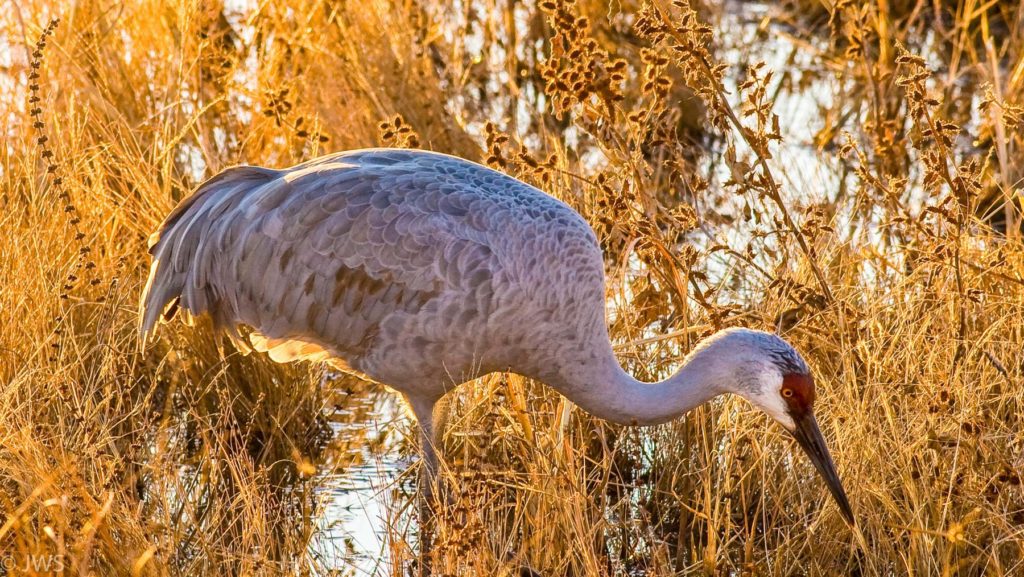Sandhill Cranes
Words and Photographs By James Skogsberg “To those for whom crane voices speak a language that resonates more strongly and more personally than any human voice, and whose messages change their lives.” (P.A. Johnsgard, Sandhill and Whooping Cranes)
 Sandhill Cranes at Sunrise, photo credit James Skogsberg
Sandhill Cranes at Sunrise, photo credit James Skogsberg
This type of poetic sentiment is what stirs people after they have seen a morning liftoff of thousands of these imposing and beautiful birds. The Sandhill cranes are the most numerous and widespread of all of the 15 crane species in the world. These social birds are usually found in flocks that count in the tens of thousands. Depending on the subspecies, Sandhill cranes can be up to 40-50 inches tall when standing with wingspans of 6-7 feet. Adults are gray with very noticeable red crowns.
 Sandhill Crane morning liftoff, photo credit James Skogsberg.
Sandhill Crane morning liftoff, photo credit James Skogsberg.
We are fortunate that these birds migrate through the lower 48 states and winter on saline lakes, salt flats and playa wetlands from West Texas into New Mexico and southeastern Arizona. Sandhill cranes are daylight migrants and can fly at up to 45 to 50 miles per hour covering up to 500 miles per day in a route between Texas/Mexico and Canada/Alaska. Sandhill cranes are omnivorous and rely on freshwater wetlands for the majority of their lifecycle. They forage in flocks and may eat frogs, snails, berries, lizards and search out large quantities of cultivated grains (corn & chufa nuts) when available. Although the crane population is relatively stable, wetlands degradation and possibly long-term effects of global warming are the major threats to their survival. They have been very resilient to changes in the environment as there is limited evidence that cranes are perhaps one of the oldest bird species with fossils dating back 10 million years.
 Sandhill Crane, photo credit James Skogsberg
Sandhill Crane, photo credit James Skogsberg
Sandhill cranes have very distinctive load calls, almost perhaps like a “bugle” generated in the long trachea that extends down the neck. Family members find young adults and chicks by distinctive calls which can be heard within thousands of roosting cranes. Distinctive patterns of body language and dancing are also used for communication. Nests are mounds of available plants and grasses. Central depressions will hold a couple of spotted buff or olive green eggs. The eggs hatch in about one month and the chicks can leave the nest within a day. The wings develop slowly and require practice flights in preparation for migration, which will occur when colder weather reduces food sources. The older cranes then lead the migration.
The most famous location for observing Sandhill cranes in the is in the central Platte Valley and along the North Platte River in Nebraska. Upwards of 80% of all cranes gather here in numbers approaching 500,000 birds. My travels have taken me to the Sulfur Springs Valley southeast of Tucson where the cranes flock at the Whitewater Draw. Most often I visit the Bosque del Apache National Wildlife Refuge near Socorro, New Mexico. At both of these locations, the cranes winter from mid-November to mid-February with flocks at Bosque del Apache reaching perhaps 20,000 with very large numbers of snow geese. It is awe-inspiring to watch the birds lift off during the early sunrise to forage and then return to their wetlands refuge at sunset.
One may join the friends of Basque del Apache to ensure this marvelous event continues into the future. (The technical information in this article was obtained and sometimes directly quoted from P.A. Johnsgard’s book and the websites for Basque del Apache NWR, The Audubon Society, and The Nature Conservancy.)
*Thank you to my naturalist friend and amazing photographer, James Skogsberg, for this wonderful essay about the Sandhill Crane.

Leave a comment
Please note, comments must be approved before they are published